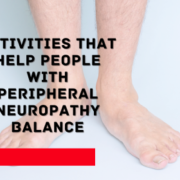Star Excursion Balance Test (SEBT)
In 1998[5,] the SEBT was first described.The SEBT may identify deficiencies in lower limb postural control. Moreover, comparing populations with injuries and healthy controls. The SEBT may be used to compare balance skills and performance across various sports. This test may be used as a sport participation screening tool as well as a post-rehabilitation test to assure dynamic functional symmetry, according to research.

The SEBT was first characterised as a rehabilitation technique that required a patient to balance on one leg while continually doing single leg squat motions to utilise the non-stance leg as far as possible along one of eight diagonal lines, each spaced 45 degrees apart [5]. Before measurements were taken, participants were encouraged to touch each of the eight lines six times.
In order to allow for the learning effect to occur and decrease measurement error, 4 trials are now generally advised in clinical and research contexts [5].Researchers also discovered that there was a significant level of variation across all 8 lines. It implies that the capacity for reaching in one direction was strongly associated with that of reaching in another[10].The modified SEBT, also known as the Y balance test, was developed to reduce the test’s variability by dividing it into three directions: anterior, posteromedial, and posterolateral.
Technique:

Standardised testing [1,5]
Anterior (ANT), posteromedial (PM) and posterolateral (PL) lines.
- Stand on the central point.
- Hands on hips.
- Reach as far as you can along the line and gently tap the line.
- Do not come to rest on the line.
- Do not transfer your body weight onto the reaching leg.
We find it intriguing that the research studies place a high focus on testing standardisation in order to get an accurate gauge and interpretation of the reach/distance conclusion. This is reasonable and most likely leads to a more precise distance measurement.
⇒What are the FACTORS AFFECTING PERFORMANCE
It is generally accepted that reach distance will be influenced by size, limb length, and sex as well.There aren’t many studies that o2utline the ideal range for human reach. Here are two more factors that affect how well you do on this exam.
Foot placement
The test’s conclusion will differ whether the heel or toes are kept on the centre point. Be careful to consistently set your feet. Don’t solely concentrate on the outcomes. Another crucial factor is foot alignment. Only taking the data into account without taking foot alignment into account might result in incorrect conclusions, particularly for anterior reach scores [4].
Although the foot positioning may have an impact on the outcomes, when researchers looked at arch control, they found no discernible reaching disparities. However, no definitive outcomes were identified. In some circumstances, having a flat foot or losing control of the arch permitted one to reach longer in the PL direction. According to research, it is not advisable to account for foot type. However, it is preferable to think of the control of the arch as the stance limb’s dynamic balancing performance[1].
Let’s concentrate on patterns of muscle activation:
A research by Earl & Hertel, which was subsequently presented in the systematic review by Gribbel et al, discovered the following:
- Anterior reach is where the vastus medialis is most active.
- In lateral reach, the vastus lateralis is the least active.
- Anterolateral reach causes the medial hamstring to contract the greatest.
- When performing posterior and posterolateral reaches, the bicep femoris was most active.
It is always encouraging to see findings like these. This aids in directing our clinical judgement. This offers us the notion or direction that, if we wish to bias certain muscles during training, we may utilise targeted reach directions.
⇒WHAT DOES THE SEBT TELL US?
The most significant change to the structure of the SEBT is reducing 8 lines to 3 lines. Here are few condition that consistently appear in the research across different patient populations:
CHRONIC ANKLE INSTABILITY (CAI)
In CAI, individuals’ reach deficiencies may be seen in all three directions. There may be a mix of several mechanical and sensory elements that contribute to the lower reach lengths [1].These authors discovered that with CAI, various orientations need various physical efforts.
Anterior reach is limited, think about mechanical restrictions and sensory deficits impact this movement. The dorsiflexion ROM is best evaluated with the knee to wall test.[3].
Eversion strength and balance control had a greater effect on posteromedial and posterolateral reach. The discrepancies in trunk rotation movement patterns were examined by the author.[9] They discovered that CAI patients are more likely to employ higher trunk flexion during anterior reach, indicating that manipulating the pelvis and trunk may be used as a method to make up for decreased ankle control.
ANTERIOR CRUCIATE LIGAMENT RECONSTRUCTION (ACLR)
The authors also investigated trunk motions in ACL patients and discovered that after an ACLR, patients are more likely to externally rotate their pelvis on the stance leg and rotate their trunk away (backwards) from the reach leg.
Following ACLR, researchers conducted a new investigation in which they discovered that patients with decreased quadricep strength had decreased reach capability in the anterior orientations while gazing above the ankle and at the knee [2]. Furthermore, it was discovered that the strength of hip abductions affects all 3 orientations. This aids in directing the course of therapy for retraining dynamic balance control. To assist patients best get ready for the next phase of their recovery, this test has to be integrated sooner into our treatment regimens.
⇒PFPS: PATELLOFEMORAL PAIN SYNDROME
A higher quadricep contraction, more ankle DF, and more loading on the patellofemoral joint are all associated with anterior reach. This direction of reach is often the most restricted in PFPS, which functionally affects a patient’s capacity to descend stairs and slopes.
⇒Adoption in a recovery programme:
The SEBT may be used to evaluate dynamic balance before creating an exercise to treat it from the trunk, hip, knee, and ankle, among other places. The example shown above is excellent for top-down instruction. Finally, we didn’t learn much about what are typical distance ranges and cut off scores for injury risk when we read all these research regarding various body parts and patient demographics. This test is non-injury specific and multifactorial. We may be used to evaluate athletes, people in active lifestyles, and professionals. The SEBT assists us in focusing on movement quality and directing our rehabilitation programmes. Strength, flexibility, neuromuscular control, core stability, range of motion (ROM), balance, and proprioception are necessary for the SEBT. The SEBT is a fantastic tool that enables us to customise our rehabilitation programmes to take into account the unique mechanical, sensory, and functional deficits.
REFERENCES:
- Gabriner, M. L., Houston, M. N., Kirby, J. L., & Hoch, M. C. (2015). Contributing factors to star excursion balance test performance in individuals with chronic ankle instability. Gait & posture, 41(4), 912-916.
- Clagg, S., Paterno, M. V., Hewett, T. E., & Schmitt, L. C. (2015). Performance on the modified star excursion balance test at the time of return to sport following anterior cruciate ligament reconstruction. journal of orthopaedic & sports physical therapy, 45(6), 444-452.
- Dill, K. E., Begalle, R. L., Frank, B. S., Zinder, S. M., & Padua, D. A. (2014). Altered knee and ankle kinematics during squatting in those with limited weight-bearing–lunge ankle-dorsiflexion range of motion. Journal of athletic training, 49(6), 723-732.
- Cuğ, M. (2017). Stance foot alignment and hand positioning alter star excursion balance test scores in those with chronic ankle instability: What are we really assessing?. Physiotherapy Theory and Practice, 33(4), 316-322.
- Gribble, P. A., Hertel, J., & Plisky, P. (2012). Using the Star Excursion Balance Test to assess dynamic postural-control deficits and outcomes in lower extremity injury: a literature and systematic review. Journal of athletic training, 47(3), 339-357.
- Gribble, P. A., Kelly, S. E., Refshauge, K. M., & Hiller, C. E. (2013). Interrater reliability of the star excursion balance test. Journal of athletic training, 48(5), 621-626.
- Earl, J. E., & Hertel, J. (2001). Lower-extremity muscle activation during the Star Excursion Balance Tests. Journal of Sport Rehabilitation, 10(2), 93-104.
- Hyong, I. H., & Kim, J. H. (2014). Test of intrarater and interrater reliability for the star excursion balance test. Journal of physical therapy science, 26(8), 1139-1141.
- De La Motte, S., Arnold, B. L., & Ross, S. E. (2015). Trunk-rotation differences at maximal reach of the star excursion balance test in participants with chronic ankle instability. Journal of athletic training, 50(4), 358-365.
- Hertel, J., Braham, R. A., Hale, S. A., & Olmsted-Kramer, L. C. (2006). Simplifying the star excursion balance test: analyses of subjects with and without chronic ankle instability. Journal of Orthopaedic & Sports Physical Therapy, 36(3), 131-137
- Olmsted LC, Carcia CR, Hertel J, Shultz SJ.Efficacy of the star excursion balance tests in detecting reach deficits in subjects with chronic ankle instability. Journal of athletic training. 2002 Oct;37(4):501.
- Image courtesy : Relationships among the Y balance test, Berg Balance Scale, and lower limb strength in middle-aged and older females Dong-kyu Lee et.al Brazilian journal of physical therapy







Leave a Reply
Want to join the discussion?Feel free to contribute!